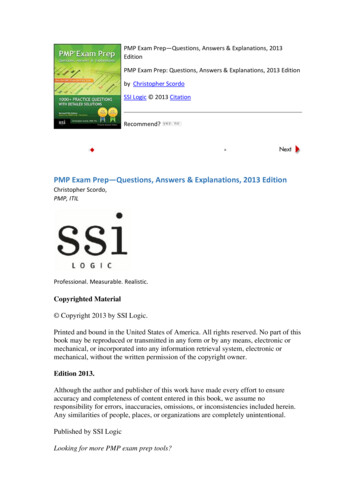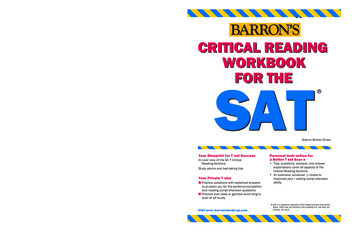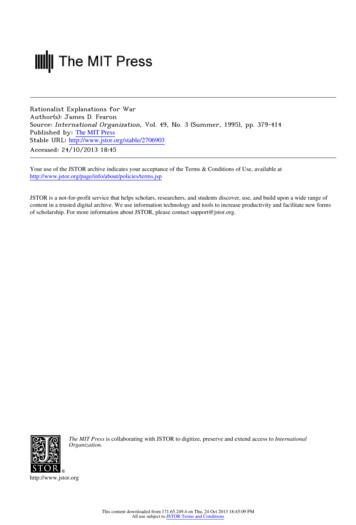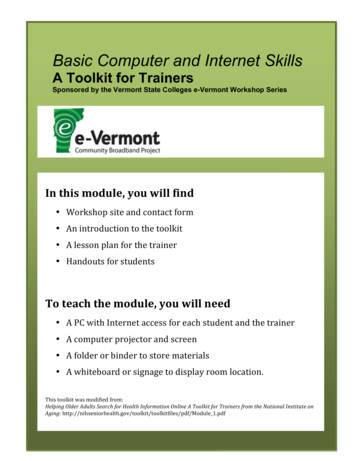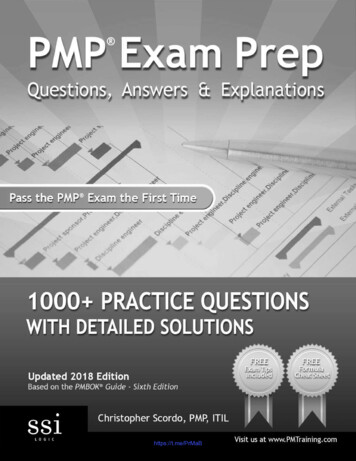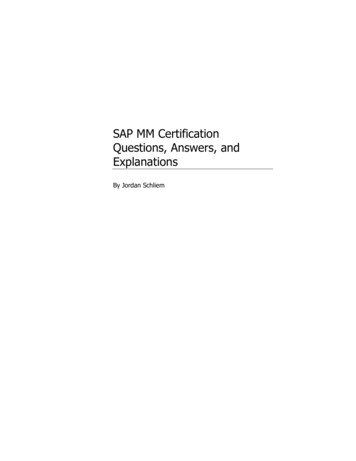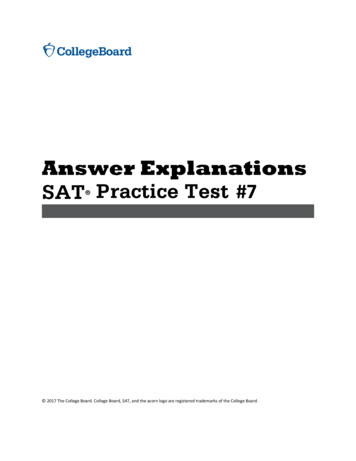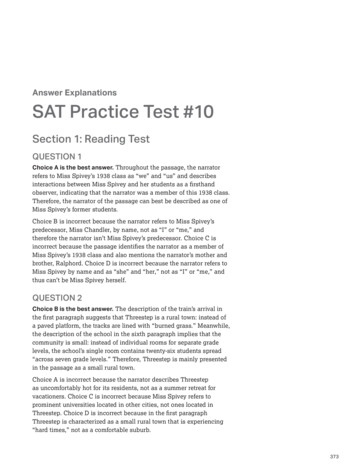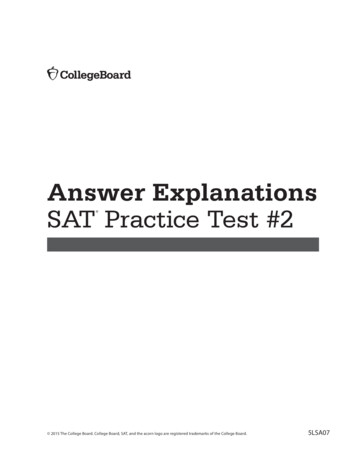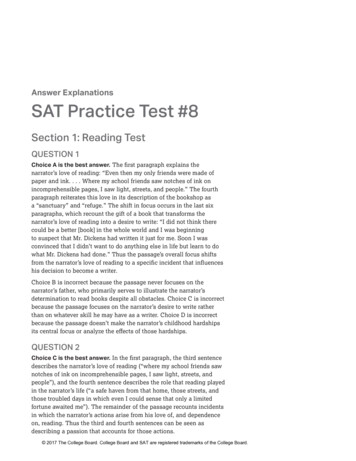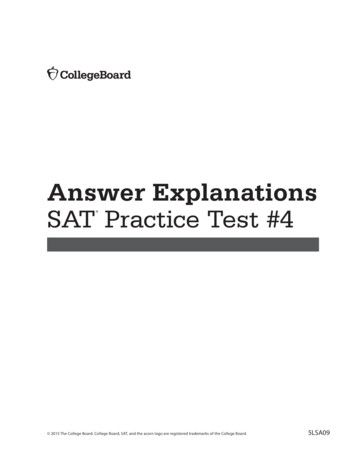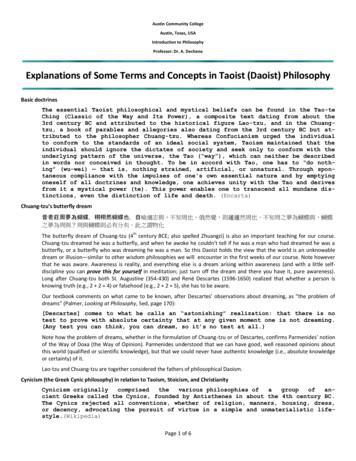
Transcription
Austin Community CollegeAustin, Texas, USAIntroduction to PhilosophyProfessor: Dr. A. DecheneExplanations of Some Terms and Concepts in Taoist (Daoist) PhilosophyBasic doctrinesThe essential Taoist philosophical and mystical beliefs can be found in the Tao-teChing (Classic of the Way and Its Power), a composite text dating from about the3rd century BC and attributed to the historical figure Lao-tzu, and in the Chuangtzu, a book of parables and allegories also dating from the 3rd century BC but attributed to the philosopher Chuang-tzu. Whereas Confucianism urged the individualto conform to the standards of an ideal social system, Taoism maintained that theindividual should ignore the dictates of society and seek only to conform with theunderlying pattern of the universe, the Tao (“way”), which can neither be describedin words nor conceived in thought. To be in accord with Tao, one has to “do nothing” (wu-wei) — that is, nothing strained, artificial, or unnatural. Through spontaneous compliance with the impulses of one's own essential nature and by emptyingoneself of all doctrines and knowledge, one achieves unity with the Tao and derivesfrom it a mystical power (te). This power enables one to transcend all mundane distinctions, even the distinction of life and death. (Encarta)Chuang-tzu’s butterfly 。此之謂物化The butterfly dream of Chuang-tzu (4th century BCE; also spelled Zhuangzi) is also an important teaching for our course.Chuang-tzu dreamed he was a butterfly, and when he awoke he couldn’t tell if he was a man who had dreamed he was abutterfly, or a butterfly who was dreaming he was a man. So this Daoist holds the view that the world is an unknowabledream or illusion—similar to other wisdom philosophies we will encounter in the first weeks of our course. Note howeverthat he was aware. Awareness is reality, and everything else is a dream arising within awareness (and with a little selfdiscipline you can prove this for yourself in meditation; just turn off the dream and there you have it, pure awareness).Long after Chuang-tzu both St. Augustine (354-430) and René Descartes (1596-1650) realized that whether a person isknowing truth (e.g., 2 2 4) or falsehood (e.g., 2 2 5), she has to be aware.Our textbook comments on what came to be known, after Descartes’ observations about dreaming, as “the problem ofdreams” (Palmer, Looking at Philosophy, 5ed, page 170):[Descartes] comes to what he calls an “astonishing” realization: that there is notest to prove with absolute certainty that at any given moment one is not dreaming.(Any test you can think, you can dream, so it’s no test at all.)Note how the problem of dreams, whether in the formulation of Chuang-tzu or of Descartes, confirms Parmenides’ notionof the Way of Doxa (the Way of Opinion). Parmenides understood that we can have good, well reasoned opinions aboutthis world (qualified or scientific knowledge), but that we could never have authentic knowledge (i.e., absolute knowledgeor certainty) of it.Lao-tzu and Chuang-tzu are together considered the fathers of philosophical Daoism.Cynicism (the Greek Cynic philosophy) in relation to Taoism, Stoicism, and ChristianityCynicism originallycomprisedthevarious philosophies ofagroupofancient Greeks called the Cynics, founded by Antisthenes in about the 4th century BC.The Cynics rejected all conventions, whether of religion, manners, housing, dress,or decency, advocating the pursuit of virtue in a simple and unmaterialistic lifestyle.(Wikipedia)Page 1 of 6
The Cynic philosophy was one of two branches of philosophy descending from Socrates (the other was Platonism), and itmay go back all the way to Parmenides (if reality is one and complete, then there is no need for riches). The Cynics believedthat the purpose of life was to live virtuously, in accordance with nature rather than in accordance with artificial social conventions. This philosophy was virtually indistinguishable from Chinese Taoism (except for its encouraging rude behavior). Itwould influence the later philosophy of Stoicism, which in turn was a major influence on the teachings of Jesus recorded inthe Christian gospels. There were wandering Cynic preachers all over the Roman Empire in the first century CE, and the Cynic philosophy was alive and well in the Empire until it faded away in the fifth century.Cynics were known not just for their philosophy of simple living but also for their rude behavior, openly showing their contempt for conventional values and for those who espoused society’s conventions. Their behavior, though not their philosophy, probably differed from typical Taoism. The Cynic movement was evangelical, and Cynics felt they had to hound peopleto get them to convert from their conventional ways.Today the word “cynical” means believing the worst of human nature and motives; having a sneering disbelief in e.g., selflessness of others. The modern concept of “cynicism” comes from the original Cynics’ mockery of conventional values, ofnormal ideas of the good life as having money, possessions, and status, and of being “nice.” Examples of exponents of theCynic philosophy in modern America would be the comedians Lenny Bruce, Bill Hicks, and George Carlin (all three now deceased).Forty sayings attributed to Jesus in the Christian gospels have been identified by New Testament scholars as probably beingteachings of Cynic evangelists who roamed Galilee in the first century CE. The teaching of the early Christian Church (evenbefore it got the name “Christian”), as evidenced by many sayings of Jesus in the gospels, was so similar to Taoism and/orCynicism that one has to suspect a link. Many of the earliest Christians called themselves the “poor,” i.e., those who feltthat the true religious life was a life of naturalness and simplicity and a rejection of artificial social conventions. When Jesusis made to say “Blessed are the poor” in the Sermon on the Mount (Mt 5:3, Luke 6:20), he was not referring to poor peoplein general, but to those who had adopted the Cynic philosophy and lifestyle.If you are interested in more on the Cynic philosophy’s praise of poverty, and its links to Parmenides, see this review in Notre Dame Philosophical Reviews.Daoist parable of the farmer whose horse ran awayChuang-tzu’s butterfly dream shows us that there is no way to tell if we are dreaming the world we think is real or not. Thisfamous parable teaches that we have no way to know in advance what is good fortune or bad, and that conventional opinions about good and evil are frequently wrong. I.e., naming cannot be trusted.There was a farmer who had an old horse for tilling his fields. One day the horseescaped into the hills and, when all the farmer’s neighbors sympathized with theold man over his bad luck, the farmer replied, “Bad luck? Good luck? Who knows?”A week later the horse returned with a herd of wild horses from the hills and thistime the neighbors congratulated the farmer on his good luck. His reply was, “Goodluck? Bad luck? Who knows?”Then, when the farmer’s son was attempting to tame one of the wild horses, he felloff its back and broke his leg. Everyone thought this very bad luck. Not the farmer, whose only reaction was, “Bad luck? Good luck? Who knows?”Some weeks later the army marched into the village and conscripted every ablebodied youth they found there. When they saw the farmer’s son with his broken legthey let him off. Now was that good luck? Bad luck? Who knows?Found at y4; also on many other sites.The Game of Life and How to Play It, by Florence Scovel Shinn (1925)The Game of Life may not seem to have anything to do with Daoism, and there is no evidence in the book that Shinn knewclassic Daoist philosophy (though she did know classical Greek philosophy). But the New Thought philosophy, which arosein New England in the latter third of the 19th century, and which Shinn’s book elaborates especially well, is actually aboutnaming, the pivotal concept in poem 1 of Tao Te Ching. So The Game can be extremely helpful for understanding the existential implications of this concept.The problem of life is this: we live in a world we have created by naming the components—things, ideas, and meanings—that make it up. To put it another way: the only world, the only life, we will ever experience is the one we have created bynaming. E.g., if you name your life “success,” you can only experience success.Page 2 of 6
When I say that the only world we experience—in fact the only world a person can experience—I don’t mean we have individually created all the things in our worlds. Rather, most of the names in our minds were passed on to us by our parentsand the society we grew up in. Example: if you grew up believing in Christianity, then there is a very good chance you didnot grow up in Saudi Arabia (this also says a lot about the supposed truths of the religions; and think of Xenophanes onthis).So to live a better life here in the illusion—and to reduce the stress of denying Tao and to work on returning home, as in theProdigal Son story—we have to teach ourselves the skill of better naming, to bring our naming more into line with Tao.Using the New Thought philosophy is not some kind of magic, and it is not something we can just use now and then whenwe want to fix some problem in our life that has popped up. It is a philosophy to live by, a disciplined way of life that mustbe deliberately practiced. Here are some of the most important practical principles of New Thought:1.First, use what Shinn calls “the Law of Substitution” to substitute old and inferior thoughts with new and more positive thoughts, thoughts that are more likely to bring happiness, success, and healing into our life-experience.2.The mind is divided into three levels, subconscious, conscious, and superconscious. Normally we get our ideas(names) about what is real in our lives from the conscious level, and it feeds these ideas to the subconscious, andthe subconscious sees to it that we experience them. But the conscious mind is the purely human mind that seeslife as it appears to be, full of death, sickness, and suffering—and it feeds these ideas to our subconscious whichcreates an experience of greater or lesser misery. We must train ourselves to go to our superconscious, our Godmind of more nearly perfect ideas, and bypass the conscious mind if we want to experience a more positive life.3.Third, the way to communicate with the subconscious is through feeling. In the stillness we must turn our newthoughts into wonderful feelings so that we can experience what we really want as if it is happening right now—never in the future. When we feel like we have what we want right now our subconscious grabs on to that experience and, sooner or later, manifests it in our life.And note: when we feel we have what we want right here and now, we have overcome desiring (you don’t desire what youfeel you have), and it’s desire that poem 1 teaches is the barrier to uniting with Tao.Great MotherAnother name for Tao (see poems 6 and 20 of Tao Te Ching). It shows the matriarchal, feminine, yin nature of this philosophy. (Christianity, which is expressed in a patriarchal ethos, refers to the ultimate reality as “Father.”)The last verse of poem 1 (“Darkness within darkness, the gateway to all understanding”) is likely referring to mystically (i.e.,in intention and in meditation) returning to the Great Mother’s womb, where we will be “born again” into a higher state ofawareness—true awakened living, in awareness of what is real and not just believing in superficial appearances and conventional anthropomorphisms.Comparison: The Hopi and Navaho call the reality underlying the manifest world “Grandmother Spider”—she weaves andmaintains the metaphysical net that holds everything together.Poem 1 of Tao Te ChingThe first poem is not only the most important of all the poems in Tao Te Ching, but is one of the most important teachingsof the correct way to do ontology and metaphysics in the history of philosophy. And, it’s supremely practical, the way to thegood life.1.The Nameless. We cannot describe reality. Later it will say that “Tao” (or “apeiron,” or “God,” etc.) is just a label ofconvenience (poem 25). We can’t say what reality is because we can only name forms, and reality is formless.2.Naming. What we can speak and think of—individual things, ideas, and sensations—is created by the human imagination.3.Desire. The imaginary world we experience is infinitely inferior to reality; at best a crappy knockoff of reality, atworst a complete denial of it. That’s why we’re always desiring more (see our texbook, page 248, on Schopenhauer’s idea that at the core of this world is an insatiable will that always wants “more”—more of anything and everything, the will doesn’t care what.) Chronic desire builds a wall between us and the experience of reality, of Tao, ofour true nature. It makes it impossible to be at peace, to experience fulfillment, to be happy, to be wise.4.Darkness (yin). We must master yang—master it, not get rid of it—and follow the yin way of stillness and wu-weiback to the experience of Tao. The Prodigal Son can only find the truly good life that he was made for by followingthe yin path, the path of darkness into ever greater darkness and reality.Page 3 of 6
The Taijitu (Tai Chi Tu) symbol, also called the yin-yang symbolRepresents the primal level of manifest reality, the primal duality out of which arise the “tenthousand things.”The Tai Chi Tu can be said to represent:The first level of manifest reality, the primal opposites (see poem 2 of Tao Te Ching) thatarise from Tao and which characterize all manifest realities. The universe of ideas and material things; the universe of separate entities.Taoism.But not Tao itself. Tao itself is beyond any possible representation in words or symbols (seethe first sentences of poem 1 of Tao Te Ching).The Indian philosophical/religious tradition speaks of duality and of the pairs of opposites that characterize the illusoryworld of forms. This is how Taoism represents the same thing (see poem 2 of Tao Te Ching).Tao (or Dao)The way, the way of nature, the way reality actually works rather than the way humans think it does or should work; andthe realistic way of life (i.e., the way of living that corresponds to reality) that harmonizes the opposites, yin and yang.The way of harmonizing the opposites is more yin than yang. Because society overemphasizes yang, the mastermust emphasize yin more than yang to restore balance in her life and surroundings.Tao is similar to the concept of “logos” in the philosophy of Heraclitus (fl. 500 BCE). This concept of logos later became important to the Stoics and Christians (the gospel of John refers to Jesus, the epitome of that religion, as thelogos, and later as “the way” (Jn 1:1 and 14:6)). But the Stoics and Christians saw logos as a principle of rationalityunderlying all manifest reality, and this emphasis on rationality is absent from Tao Te Ching and from Heraclitus.Note that both the gospel of John and Tao Te Ching believe that their philosophy of simple and natural living—i.e.,following Tao or the Way—is the only way back to “the Father” (in Christianity) or to “the Great Mother” (in Taoism). E.g., Jesus is made to say "I am the way, the truth, and the life. No one comes to the Father except throughme." (Jn 14:6)Te (or De)Power, specifically in Tao Te Ching, the power of Tao.The power of Tao is the power of wisdom, the power to live harmoniously with reality, with the way things actuallyare rather than the way humans imagine they are or should be.Comparison: In the Christian gospels the power of logos is so great that once mastered it can “move mountains.”(Mt 21:21) Our mental and emotional mountains are the problems that we create by not living harmoniously withnature. (Shinn’s book is a course on specific techniques needed if you want to move the mountains in your life.)TzuA master, a man or woman who has realized (i.e., made real in his or her life) the nature of Tao and who has developed te,the power of Tao.YangMale principle; light, white; left brain.Think of the story of the Toltec dreamer at the start of don Miguel Ruiz’s The Four Agreements: When he stared upinto the night sky at first he thought the stars must be the primal lights, then he realized it was the darkness (yin)that was primal, and that the stars are the “children” born of the mysterious darkness. This is the same darknessmost of us see in meditation, which turns out, paradoxically, to be the great light (pure consciousness withoutthought), the source of all other lights. Some mystics have referred to the primal light as the “dazzling darkness.”Classical Greek thought saw the sun as at least a symbol of ultimate realization, and it knew that the sun was nourished and then reborn in the darkness every day—thus enlightenment was seen as depending on going into thedarkness. For example, Parmenides starts his philosophical poem by having the “Daughters of the Sun” transporthim to the underworld to find truth.Page 4 of 6
Being born into existence, leaving the Great Mother, leaving the way of eternity, is yang, and we won’t be happyuntil we return to our eternal home (think of the Prodigal Son story). Return is yin.YinFeminine principle; dark, black (as, inside the Great Mother’s womb, the emptiness—formlessness—in which all formscome into being); right brain.Question: Tao Te Ching emphasizes yin. Why is this, shouldn’t it teach a balance of yin and yang, as symbolized inthe Taijitu? Doesn’t this mean that the teaching of Tao Te Ching is unbalanced? And: what’s it got against us guys?Answer: This world has come to greatly overemphasize yang, the assertive/aggressive way of life of always acting,meddling, trying to change and improve things, grasping for worldly goods and trying to escape evils, and using violence when things don’t go the way we want them to (see poem 38 of Tao Te Ching). To follow yin means to correct this imbalance, and in so doing find the way back to Tao, which alone is true reality.Further: Tao itself, the empty center of the wheel (etc.), is yin and is what we have to find and abide in if we are tobe happy and powerful. See poems 6 and 21 of Tao Te Ching.Most people superimpose the yang of everyday concerns over Tao so that they forget all about it and pay no attention to it.The Three Ws of Tao Te Ching (of course these are only Ws in English translation)WaterThere are at least eight overlapping dimensions and meanings to this metaphor for Tao and for the Taoist:1.Water runs downhill, seeking lowly places. Tao is humble (unlike the supreme realities of the theistic religions,such as the anthropomorphic Yahweh/Jehovah and Allah).2.Water seeks stillness.3.When water is still, it naturally becomes clear in time, the dirt in it settles out.4.Water nourishes all things without trying. Stillness of itself heals. (Here is a mantra or affirmation for your meditations: “There is nothing my stillness cannot heal.”)5.Water blesses all things without discriminating some as more deserving than others. This is nondualism.6.Water normally works so slowly and gracefully its power and accomplishments go unnoticed (think of the Colorado River creating the Grand Canyon).7.Water goes around obstacles, it “resists not.”8.Though water is soft, it wears away the hardest things.Wu-wei (or wei-wu-wei, doing that looks like not-doing)“To be in accord with Tao, one has to “do nothing” (wu-wei)—that is, nothing strained, artificial, or unnatural.”(Encarta). Wu-wei is skillful action without forcing things.Also: Unpremeditated action; seemingly effortless work; graceful effort; working “in the zone”; nearly frictionlessaction (i.e., with no wasted effort); work that doesn’t look like work; not forcing.Example of the wu-wei concept from Nisargadatta Maharaj (not a Daoist but a great Hindu saint and Advaita Vedanta master, 1897-1981, a poor man who lived in the Mumbai slums with his family): Whenyou’re enlightened—when you’ve realized what you are—work flows out of you almost automatically, it’sas easy as growing hair or digesting your food. You’ve given over the work to your great self (instead ofyour puny, artificial self) and you let it use your little self as its instrument. When you’ve become what theHindus call the Witness, the things you need to have happen in your life just seem to happen, all of theirown accord, without effort. That’s wu-wei.WheelThe most important of several emptiness images for Tao.A wheel seems to be made of a hub, spokes, and a rim, and few people pay attention to the hole in the centersince it’s just empty, nothingness. But it’s the hole in the center that makes the wheel work. That’s Tao, the realityPage 5 of 6
behind the universe of temporary, imperfect, and unsatisfying forms. A master is like that: no one notices her, it’slike she’s not there, anonymous, totally ignored, just empty space, Tao incarnate.Very few people notice the space around things (however, artists and decorators often do). Empty spaceis the best metaphor for Being, because without space no form could appear, and Being is that which isleast recognized and appreciated by the mass of humans. If you think in traditional religious terms of acreator God and its creatures, Being is the unseen, infinite, and eternal God that we generally ignore (inreligious terms, humans tend not to “obey” God), and this God’s creatures are the innumerable temporary and imperfect forms.Comparison: The Hindu Brihadaranyaka Upanishad (3, 8, 6-8) also says that space (akasha) is the closestthing in the world of forms to the infinite (Akshara, an epithet for Brahman). Four of the five elements(earth, water, fire, air) are enclosed within the fifth element, space, and space is, metaphorically, enclosedwithin boundless Brahman.The wheel is always turning, moving, changing—an image of the incessantly changing world of illusion—but thecenter is motionless and empty, and outside space and time.Compare Plato’s cave allegory: The underground cave had a big opening that let some outside light in.Without at least a little light even the illusion couldn’t exist. So, without the hole at the center of thewheel, the illusion of an incessantly moving and changing world could not exist.Therefore: Know and imitate emptiness while living and acting in the world of forms. Compare MahayanaBuddhism, shunyata (emptiness) and the two truths.The wheel of illusion’s constant motion causes a centrifugal force that throws us out, away from the center. That’s yang, the opposite of stillness and wu-wei, yin. We go crazy when we are out of touch with ourcenter. There is no peace on the edge of the wheel, only in the formless center, but we can’t get back tothe center with ordinary effort, the centrifugal force is too strong. The work of getting back to the center—of being a master of life—requires a subtle (esoteric) art and philosophy called the Way (Tao), ratherthan the clumsy (exoteric) way of will-power and hard work. It is wu-wei. Tao Te Ching is inviting you tobecome a wu-wei master, a master of life.Copyright 2004-2011, Arthur C. Dechene, Jr. Updated February 4, 2011.Page 6 of 6
The essential Taoist philosophical and mystical beliefs can be found in the Tao-te Ching (Classic of the Way and Its Power), a composite text dating from about the 3rd century BC and attributed to the historical figure Lao-tzu, and in the Chuang-tzu, a book of parables and allegories als
